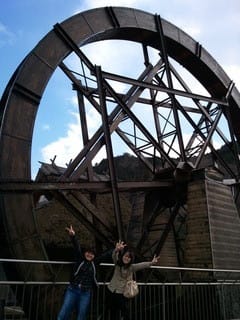2012年5月27日(日)、日本一の親子孫水車がある新見市神郷の夢すき公園で神郷太鼓田植が行われます。
 (これは、ゼミ生たちと水車を見に行った時の写真です。2011年度山内ゼミ打ち上げ参照)
(これは、ゼミ生たちと水車を見に行った時の写真です。2011年度山内ゼミ打ち上げ参照)
It is Sunday, May 27th, 2012 today. Right now, we are just in front of Oyako-mago Suisha, which is Waterwheels of Three Generations in Yume-suki Park. Here we are going to introduce “Shingo-Taiko-Daue” which is rice planting along drumbeat in Shingo area.
This is an area called “Shimo-kojiro, Shingo, Niimi” and located in the western part of Niimi City, about 15 minutes from Central Niimi by car. Here in Yume-suki Park, there is a landmark named “Japan’s Largest Waterwheels of Three Generations.” We can experience traditional Japanese paper making here. According to documents, waterwheels were invented in the ancient Mesopotamia Era, and were used to irrigate their farmlands. In Japan, waterwheels were used to irrigate rice paddies, polish rice and mill flour.
Taiko-Daue is stemmed from a traditional Japanese performance of Dengaku, which is a combination of music and dance, and dates back to the middle of Heian Era (around the year 1000 AD). This traditional performance has been carried down in rural areas along Chugoku Mountain Range. In areas like Niimi, Okayama, and rural areas of Hiroshima and Shimane Prefectures, rice planting was done with singing of rice planting songs and beat of rhythm bamboo and drums.
The place name “Kojiro” literally means “rice paddies for dedication to gods.” Taiko-Daue is said to start in the middle of Edo Era (around 1700) as a festival to deify the gods of rice paddies. In this ritual, hard task of rice planting is intended to become lighter and merrier, then more efficient with “Saotome” maidens singing rice-planting songs and planting rice, along with “Sage” men’s drumbeats. In this area, Taiko-Daue had been done gaily until around 1950s, with young married couples of “Sage” and “Saotome” traveling around for two weeks.
Then, with development of agricultural techniques and mechanized farming, this kind of group rice-planting went obsolete. But in 1971, Kojiro Traditional Music Conservation Association was founded in order to hand down the wonderful rice-planting events. From 1999 on, this event takes place every year in this site and tradition was handed down to fifth and sixth graders of Kojiro Elementary School. In 2008, this tradition was designated as significant intangible folk cultural asset.
In this event, the most important part is “Sage” men who beat the drum. Efficiency of rice-planting depends upon the technique of “Sage” men. A “Sage” man suspends a drum with a sash from his left shoulder to the right side. He beats drums with sticks and sings rice-planting songs.
Along with the drumbeat, “Saotome” maidens plant rice with rice planting songs. “Saotome” maidens make a line facing the “Sage” man. The line moves backward after planting a line of rice seedling.
Taiko-Daue consists of the chases of “Sage” men and “Saotome” maidens. The speed of the planting depends on the technique of “Sage” men’s drumbeat. A “Sage” is a conductor as well as a drummer.
“Sage” men have to not only beat drums but also recite numerous rice-planting songs. He sings about 600 songs a day in average.
The order of songs is usually standard. “Asa-uta,” which is the morning song starts a day. Then, each song is sung according to the time, and in the afternoon when everybody gets tired, erotic songs are sung in order to energize the workers. The rice-planting songs mean not only streamlining but praying for good harvest to the gods of rice paddies as well.
These years, Taiko-Daue is performed as an annual event in the rice paddy in the opposite side of river from Yume-suki Park of Waterwheels of Three Generations. This rice paddy is about 18 meters square. The ritual is greatly shortened to about one-hour ceremony, but rice planting songs are performed by members of Kojiro Traditional Music Conservation Association.
Male sixth graders of Kojiro Elementary School play “Sage” men, and female sixth graders play “Saotome” maidens. It is lovely to see this ritual is performed by boys and girls.
Other than Taiko-Daue, we have Shingo Drum performance by Shingo Taiko Conservation Group, Kagura performance (Oni no Mai dance and Daikoku Mai dance) by Shinmeisha Kagura Group, Kashirauchi by younger children of Kojiro Elementary School, and photo contest of Taiko-Daue. There are food stalls selling local foods such as Chiya Beef Barbecue and Tamago-kake-gohan (rice with beaten egg), and vegetables like tomatoes.
 (これは、ゼミ生たちと水車を見に行った時の写真です。2011年度山内ゼミ打ち上げ参照)
(これは、ゼミ生たちと水車を見に行った時の写真です。2011年度山内ゼミ打ち上げ参照)It is Sunday, May 27th, 2012 today. Right now, we are just in front of Oyako-mago Suisha, which is Waterwheels of Three Generations in Yume-suki Park. Here we are going to introduce “Shingo-Taiko-Daue” which is rice planting along drumbeat in Shingo area.
This is an area called “Shimo-kojiro, Shingo, Niimi” and located in the western part of Niimi City, about 15 minutes from Central Niimi by car. Here in Yume-suki Park, there is a landmark named “Japan’s Largest Waterwheels of Three Generations.” We can experience traditional Japanese paper making here. According to documents, waterwheels were invented in the ancient Mesopotamia Era, and were used to irrigate their farmlands. In Japan, waterwheels were used to irrigate rice paddies, polish rice and mill flour.
Taiko-Daue is stemmed from a traditional Japanese performance of Dengaku, which is a combination of music and dance, and dates back to the middle of Heian Era (around the year 1000 AD). This traditional performance has been carried down in rural areas along Chugoku Mountain Range. In areas like Niimi, Okayama, and rural areas of Hiroshima and Shimane Prefectures, rice planting was done with singing of rice planting songs and beat of rhythm bamboo and drums.
The place name “Kojiro” literally means “rice paddies for dedication to gods.” Taiko-Daue is said to start in the middle of Edo Era (around 1700) as a festival to deify the gods of rice paddies. In this ritual, hard task of rice planting is intended to become lighter and merrier, then more efficient with “Saotome” maidens singing rice-planting songs and planting rice, along with “Sage” men’s drumbeats. In this area, Taiko-Daue had been done gaily until around 1950s, with young married couples of “Sage” and “Saotome” traveling around for two weeks.
Then, with development of agricultural techniques and mechanized farming, this kind of group rice-planting went obsolete. But in 1971, Kojiro Traditional Music Conservation Association was founded in order to hand down the wonderful rice-planting events. From 1999 on, this event takes place every year in this site and tradition was handed down to fifth and sixth graders of Kojiro Elementary School. In 2008, this tradition was designated as significant intangible folk cultural asset.
In this event, the most important part is “Sage” men who beat the drum. Efficiency of rice-planting depends upon the technique of “Sage” men. A “Sage” man suspends a drum with a sash from his left shoulder to the right side. He beats drums with sticks and sings rice-planting songs.
Along with the drumbeat, “Saotome” maidens plant rice with rice planting songs. “Saotome” maidens make a line facing the “Sage” man. The line moves backward after planting a line of rice seedling.
Taiko-Daue consists of the chases of “Sage” men and “Saotome” maidens. The speed of the planting depends on the technique of “Sage” men’s drumbeat. A “Sage” is a conductor as well as a drummer.
“Sage” men have to not only beat drums but also recite numerous rice-planting songs. He sings about 600 songs a day in average.
The order of songs is usually standard. “Asa-uta,” which is the morning song starts a day. Then, each song is sung according to the time, and in the afternoon when everybody gets tired, erotic songs are sung in order to energize the workers. The rice-planting songs mean not only streamlining but praying for good harvest to the gods of rice paddies as well.
These years, Taiko-Daue is performed as an annual event in the rice paddy in the opposite side of river from Yume-suki Park of Waterwheels of Three Generations. This rice paddy is about 18 meters square. The ritual is greatly shortened to about one-hour ceremony, but rice planting songs are performed by members of Kojiro Traditional Music Conservation Association.
Male sixth graders of Kojiro Elementary School play “Sage” men, and female sixth graders play “Saotome” maidens. It is lovely to see this ritual is performed by boys and girls.
Other than Taiko-Daue, we have Shingo Drum performance by Shingo Taiko Conservation Group, Kagura performance (Oni no Mai dance and Daikoku Mai dance) by Shinmeisha Kagura Group, Kashirauchi by younger children of Kojiro Elementary School, and photo contest of Taiko-Daue. There are food stalls selling local foods such as Chiya Beef Barbecue and Tamago-kake-gohan (rice with beaten egg), and vegetables like tomatoes.





















